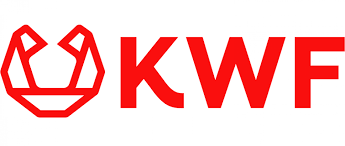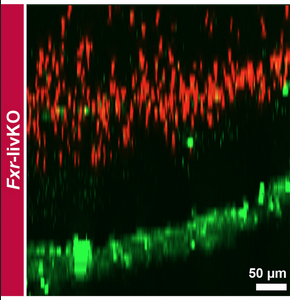Spatial omics identifies potential inflammatory risk factors for development of colitis-associated cancer in IBD
In our latest paper we used spatial transcriptomics and proteomics to identify specific risk factors at early stages of cancer development in patients with Inflammatory bowel disease (Crohn’s and Ulcerative colitis). Many patients undergo regular surveillance endoscopy, to remove any potential malignant growths. Besides this being a high burden for the patients, it remained unclear which inflammatory factors are responsible for the higher risk of cancer development. Hence complicating choices for treatment which could either reduce or worsen this risk. We identified elevated inflammatory factors, namely cytokines (IL17), signaling pathways (JAK-STAT signaling) in both epithelium and immune cells that were elevated only in patients that developed dysplasia. Since drugs for these pathways exist, future research should demonstrate whether such specific treatments benefit IBD patients at risk of cancer development by both reducing inflammation and preventing cancer development.. We thank the fantastic team of collaborators from the clinic, biostatistics, and multi-scale spatial omics platform. Congratulations to the team, especially Matthijs Baars and Evelien Floor and our partners in IBD research from the Oldenburg group.
We dedicate this to the memory of Neeraj Sinha, co-first author of this work.
High Tumor- T cell distance differentiates metastatic colon cancers
In our study led by Matthijs Baars and Emre kucukkose, in close collaboration with the team of Onno Kranenburg and fantastic clinical collaborators from the Cancer center, we set out to uncover risk factors for colon cancer metastasis. We explored the tumor immune microenvironment of primary tumors from patients with MSI-colon cancers and compared tumors that either did or did not metastasize. We found that while cytotoxic T cells are present in simllar numbers, they locate completely different: In metastatic tumors the T cells localized far away from the tumor within the stromal region and showed no signs of activation, while in the non-metastatic tumors the T cells directly localized with the tumor cells. Of note, with funding from the Sacha Swarttouw-Hijmans foundation we are currently explanding the numbers of samples t to explore whether we can use this as a biomarker to predict risk of metastatsis with Dr. Jeanine Roodhart and Dr. Sjoerd Ellias. Read more in our published story at British Journal of Cancer
What does LEGO have to do with our Research?
In honor of her appointment as Associate Professor this year, Yvonne Vercoulen recorded a 2-minute research pitch explaining why studying the spatial organization of cells in a tissue is important to comprehend disease development, progress and therapy response. Curious? Go to YouTube and turn on any language subtitles to watch it!
Kick-off TOPGut MSCA-doctoral network
At TU Berlin we enjoyed a fantastic and fun kick-off event of the TOP GUT consortium. With tthe aim to develop Gut-on-a-Chip systems incorporating all facets relevant in cancer development and chronic disease, ideas and plans were actively discussed. Faranak Heidari presented her project at the Utrecht University with Dr. Silvia Mihaila and Roos Masereeuw in collaboration with the Vercoulen lab where she will engineer crypt-villi patterns in a gut-barrier on a chip system using organoids.. This project will promote availability of in vitro models to study immune-epitheilial, microbiome-, and epitheilial-stromal interactions, as well as permeability and absorption of the mucosal barrier in cancer and Inflammatory Bowel Disease and test mechanisms of therapy response vs resistance. We are excited to start working in this exciting consortium and push the limits to improve in vitro model systems.
In our memories: Neeraj Sinha
With great sadness we say farewell to our gentle-hearted and cheerful former colleague Neeraj Sinha. He worked with us as a postdoc and made valuable contribution to multiple research projects. We are grateful to have had the pleasure to work with him, and he still brought his positive energy to our lab dinners and parties after he left our lab. We wish to express our condolences to Neeraj’s family, he will be dearly missed.
Paper alert: T cell location in the tumor matters for dMMR colon cancer metastasis
Congratulations to Emre and Matthijs for the successful finish of their collaborative project manuscript! A fantastic collaborative effort between the Kranenburg & Vercoulen labs with our outstanding clinical team with experts in oncology & pathology. We identified a potential spatial biomarker in primary tumor for metastasis of MSI-hi/MMRd colorectal cancer. We will follow this up in extended cohorts in new research projects, funded by Sacha Swarttouw Hijmans Stichting. Here you can find the preprint, and the publication will come out soon @ British Journal of Cancer. Preprint: Stromal localization of inactive CD8+ T cells in metastatic mismatch repair deficient colorectal cancer BioRxiv 2023, DOI: 10.1101/2023.10.09.561039 Highly multiplexed spatial analysis identifies tissue-resident memory T cells as drivers of ulcerative and immune checkpoint inhibitor colitis
https://www.cell.com/iscience/pdf/S2589-0042(23)01968-5.pdf
Congratulations to Mick and all others who worked hard on this story, unraveling the immune cells driving toxicity (colitis) in patients treated with immune checkpoint inhibition. We show that activated, proliferating Tissue-resident memory CD8+ T cells are causing trouble in the colon.
Kick-off project JAKi-MOA: unraveling JAK signaling in IBD
@matthijsbaars
We are excited to announce that Evelien Floor has initiated her PhD training and aims to unravel how JAK signaling and interference with JAK inhibitors affects cells in the gut of patients with Inflammatory Bowel Disease using Spatial Omics. Evelien will collaborate with MD/PhD candidate Jonas Louwers, and we thank Galapagos for sponsoring this collaborative project with Bas Oldenburg and Femke van Wijk.
Kick-off Cocoon project
In the last months we have set the first steps of an exciting collaborative project with the teams of Monique Verstegen (Erasmus MC) and Gijsje Koenderink (TU/Delft) to unravel the tumor microenvironment of cholangiocarcinoma. We welcome Aleksandra Makowiecka, who is driving this collaboration with great enthusiasm and skill, and thank KWF Kankerbestrijding for their support!
Novel review on multiplex spatial analysis in cancer
Multiplex Tissue Imaging: Spatial Revelations in the Tumor Microenvironment . van Dam S, Baars MJD, Vercoulen Y. Cancers 2022
Our review on how the latest spatial tumor microenvironment analysis has impacted cancer research and patient diagnosis/prognosis was published! read more HERE. Congratulations to Stephanie and Matthijs!
Multiplex Tissue Imaging: Spatial Revelations in the Tumor Microenvironment. Cancers 2022
Structures of Strength- Gut Barrier Challenge continues!
SoS Gut Barrier Challenge
Image by: E. Floor @CMM_UMCU
SoS interdisciplinary consortium received renewal of funding from the Center for Unusual Collaborations. SoS consists of research teams from UMCU, UU, TU/e, WUR, and investigates porosity. We are happy to proceed developing innovative assays to test effects of inflammation and microbiome on the Gut Barrier, and look forward to take on this interdisciplinary Challenge!
T1/T17 drive Dupilumab-induced eye inflammation
Novel effective eczema drug dupilumab (IL4/IL13 blockade) can induce toxicity resulting in severe uveitis. In this collaborative study we demonstrate with multiplex IMC analysis of eye tissue that this toxic response is driven by T1/T17 inflammation. Published in Allergy last week! We thank Daphne Bakker, Femke van Wijk for a fruitful and exciting collaboration.
Liver-gut axis controls the colonic mucus barrier via hepatic FXR.
Collaborative contribution on imaging analysis of mucus barrier, published in J Hep Reports. Congrats to all and thanks to Noortje Ijssennagger and Saskia van Mil for the fun collaboration!
MATISSE method single-cell spatial analysis out now
May 11th our novel method for IMC& microscopy analysis “MATISSE” has been published. This team-effort spearheaded by Matthijs Baars allows high-quality single-cell analysis in tissue. The paper is open-access and contains a manual, with all scripts and data available. Updated with publisher correction for Fig 1A.
Artist: Matthijs J.D. Baars
Launch multidisciplinary project Structures of Strength
Center for Unusual collaborations has funded it’s first collaborative projects, allowing unusual multidisciplinary teams to tackle big societal problems. Yvonne is amongst the first group of CUCo fellows, and will contribute to the development of a novel platform Structures of Strength.
‘T cells lose GRP in autoimmunity’ story out in Eur J Immunology!
Congrats to the lab, first author Matthijs, and our amazing collaborators! Thanks EJI for a nice highlight ‘In this issue’ :T cells lose GRP in autoimmunity’. We show a novel regulatory mechanism of RasGRP1 expression that underlies autoimmunity. Read more here.
Should research balance curiosity with societal impact?
Yvonne Vercoulen , Assistant Professor at the Center for Molecular Medicine in the University Medical Center Utrecht, discusses the importance of curiosity-driven, fundamental research in the first blog of the Utrecht Young Academy.
RASGRP1 story Matthijs published.
Congrats to the lab and our amazing collaborators! In short: we describe a novel regulatory mechanism of RasGRP1 expression that underlies autoimmunity. Read more here.


















